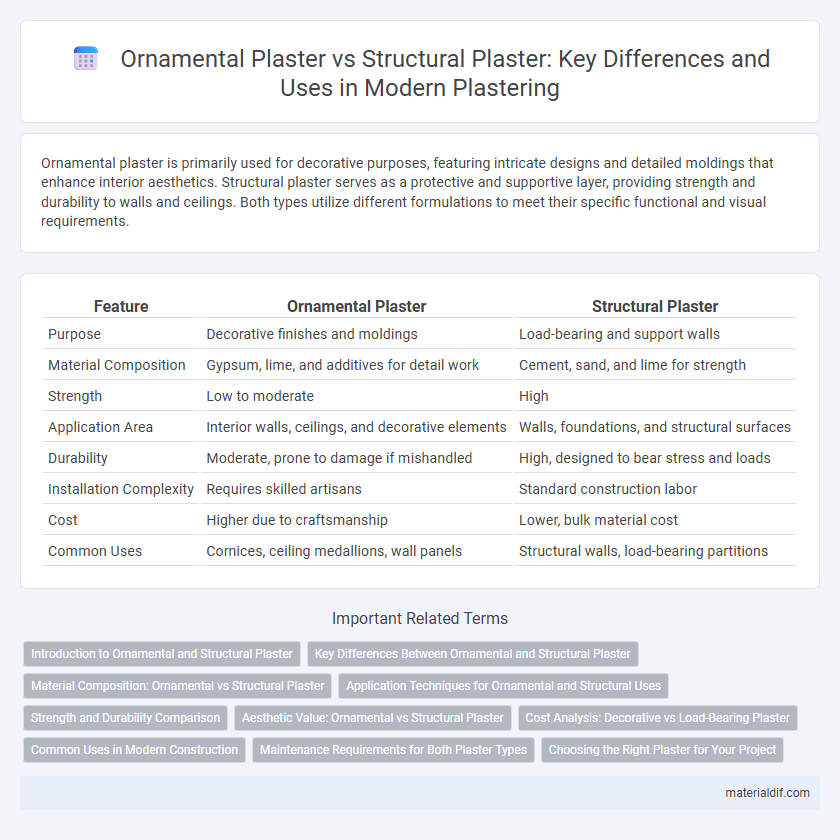Ornamental plaster is primarily used for decorative purposes, featuring intricate designs and detailed moldings that enhance interior aesthetics. Structural plaster serves as a protective and supportive layer, providing strength and durability to walls and ceilings. Both types utilize different formulations to meet their specific functional and visual requirements.
Table of Comparison
| Feature | Ornamental Plaster | Structural Plaster |
|---|---|---|
| Purpose | Decorative finishes and moldings | Load-bearing and support walls |
| Material Composition | Gypsum, lime, and additives for detail work | Cement, sand, and lime for strength |
| Strength | Low to moderate | High |
| Application Area | Interior walls, ceilings, and decorative elements | Walls, foundations, and structural surfaces |
| Durability | Moderate, prone to damage if mishandled | High, designed to bear stress and loads |
| Installation Complexity | Requires skilled artisans | Standard construction labor |
| Cost | Higher due to craftsmanship | Lower, bulk material cost |
| Common Uses | Cornices, ceiling medallions, wall panels | Structural walls, load-bearing partitions |
Introduction to Ornamental and Structural Plaster
Ornamental plaster is a decorative material used to create intricate moldings, cornices, and ceiling medallions that enhance architectural aesthetics with fine detail and artistic design. Structural plaster serves a functional purpose, providing a protective layer that strengthens walls and ceilings, improves fire resistance, and ensures durability in construction. Both types play essential roles in building design, with ornamental plaster focusing on visual appeal and structural plaster emphasizing support and longevity.
Key Differences Between Ornamental and Structural Plaster
Ornamental plaster primarily serves decorative purposes, featuring intricate designs and detailed moldings used to enhance interior aesthetics, whereas structural plaster provides strength and durability by reinforcing walls and ceilings. Key differences include composition, where ornamental plaster often contains finer aggregates for smooth finishes, while structural plaster incorporates harder materials for load-bearing capabilities. Installation techniques also vary, as ornamental plaster requires delicate craftsmanship for artistic precision, whereas structural plaster prioritizes functional application to ensure stability and protection.
Material Composition: Ornamental vs Structural Plaster
Ornamental plaster typically consists of gypsum, lime, and additives such as fibers and marble dust to enhance texture and detail, making it ideal for decorative moldings and intricate designs. Structural plaster, on the other hand, contains stronger materials like cement, sand, and lime to provide durability and load-bearing capacity for walls and ceilings. The difference in material composition directly affects their functionality, with ornamental plaster prioritizing aesthetics and structural plaster focusing on strength and stability.
Application Techniques for Ornamental and Structural Uses
Ornamental plaster requires precise application techniques such as molding, casting, and hand-carving to create intricate textures and decorative patterns on ceilings and walls. Structural plaster is applied using troweling and layering methods that emphasize durability and strength, often incorporating reinforcing materials in load-bearing walls and ceilings. Mastery in mixing plaster with specific additives ensures optimal adhesion and finish tailored for either delicate ornamental designs or robust structural support.
Strength and Durability Comparison
Ornamental plaster, designed primarily for decorative purposes, typically has lower strength and durability compared to structural plaster, which is engineered to bear loads and withstand environmental stresses. Structural plaster incorporates reinforcing materials such as fibers or mesh, enhancing its resistance to cracking and impact, making it suitable for walls and ceilings in high-traffic areas. The durability of structural plaster translates to longer service life and reduced maintenance costs, whereas ornamental plaster requires careful handling to prevent damage.
Aesthetic Value: Ornamental vs Structural Plaster
Ornamental plaster enhances aesthetic value by providing intricate designs, decorative moldings, and artistic finishes that elevate interior spaces with elegance and sophistication. Structural plaster serves a primarily functional role, offering durability, fire resistance, and surface protection without emphasizing decorative appeal. The choice between ornamental and structural plaster depends on balancing visual impact with practical performance requirements.
Cost Analysis: Decorative vs Load-Bearing Plaster
Ornamental plaster typically costs more due to intricate designs and finer materials, with prices ranging from $10 to $30 per square foot, compared to structural plaster which averages $5 to $15 per square foot for essential load-bearing applications. Decorative plaster requires skilled artisans and longer installation times, increasing labor expenses, while structural plaster involves faster application focused on strength and durability. Budget considerations must weigh the aesthetic value of ornamental plaster against the functional cost-efficiency of structural plaster in construction projects.
Common Uses in Modern Construction
Ornamental plaster is widely used in modern construction for decorative purposes such as ceiling moldings, cornices, and intricate wall designs, enhancing architectural aesthetics. Structural plaster, on the other hand, serves functional roles including fireproofing, sound insulation, and surface leveling in walls and ceilings. Both types play crucial roles, with ornamental plaster emphasizing visual appeal while structural plaster ensures durability and safety in buildings.
Maintenance Requirements for Both Plaster Types
Ornamental plaster requires regular cleaning and occasional touch-ups to preserve its intricate details and prevent cracking caused by environmental factors. Structural plaster demands routine inspections to identify and repair any damage affecting the building's integrity, such as moisture intrusion or impact cracks. Proper maintenance of both plaster types ensures longevity, aesthetic appeal, and structural safety in diverse architectural applications.
Choosing the Right Plaster for Your Project
Ornamental plaster is ideal for decorative elements such as moldings, cornices, and ceiling medallions, offering detailed design and aesthetic appeal. Structural plaster provides strength and durability for walls and ceilings, enhancing fire resistance and sound insulation in construction. Selecting the right plaster depends on whether the project prioritizes decorative features or structural integrity to ensure optimal performance and visual impact.
Ornamental plaster vs Structural plaster Infographic

 materialdif.com
materialdif.com